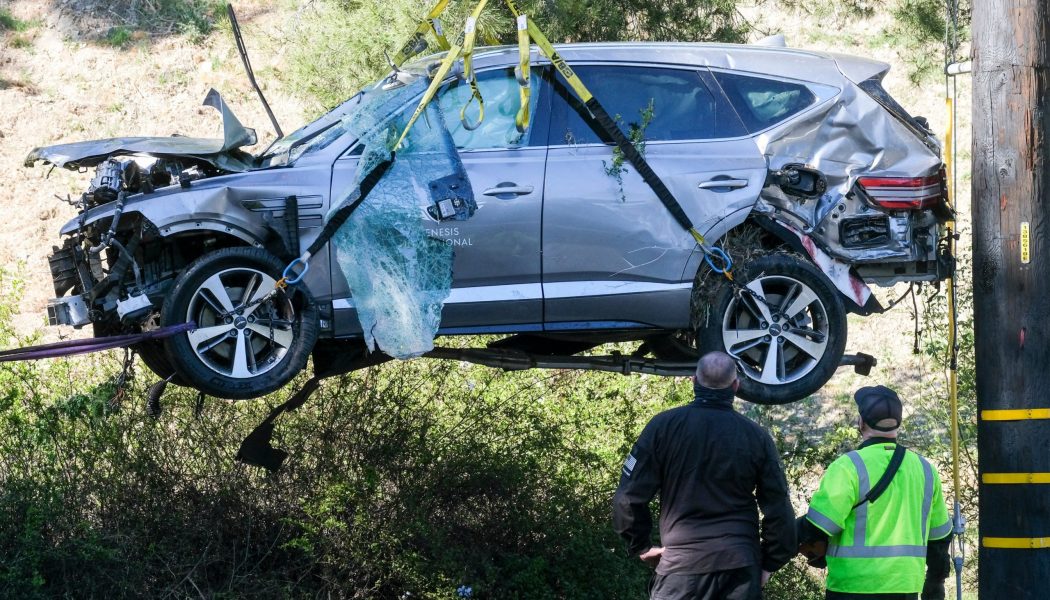The Los Angeles Sheriff’s Department held a news conference today with updates on star golfer Tiger Woods’ single-vehicle crash on February 23 and revealed his Genesis GV80 SUV hit a top speed of 87 mph during the incident. The department blamed pedal misapplication (pressing the gas instead of the brake in a moment of panic), unsafe speed, and an inability to negotiate the curve in the road. The posted speed limit is 45 mph.
Woods was driving northbound on Hawthorne Boulevard in the city of Rolling Hills Estates in a Genesis GV80 luxury SUV at the time of the crash. This section of road is a steep downhill that sheriff’s representatives called out as having an abnormally high number of crashes due to speeding.
The Crash Itself: A Recap
According to Captain Jim Powers of the LASD’s Lomita office, which investigated the crash, Woods was traveling between 68 mph and 89 mph during the collision. Based on graphics shared by the Sheriff’s Department, Woods appears to have entered a righthand bend at high speed and understeered to the left, toward the outside of the turn. The vehicle jumped the center median, drove through a sign in the median, crossed the southbound lanes, jumped the sidewalk on the far side, and struck a tree 71 feet off the road. The impact with the tree sent the vehicle airborne and caused it to partially spin, landing on its side.
The GV80’s Event Data Record, commonly known as a “black box,” was recovered and examined under search warrant on March 1. According to Powers, the EDR recorded two events correlated to the impact with the sidewalk curb after the vehicle crossed the oncoming lanes and the impact with the tree. Together, the two recorded events provide a seven-second window into what the vehicle was doing right before impact. The EDR recorded speeds between 82 mph and 89 mph when the vehicle jumped the median, 75 mph when it jumped the sidewalk, and 68 mph at the time of impact with the tree.
The EDR also recorded the position of the vehicle’s pedals and showed the accelerator pedal at 99 percent and the brake pedal at zero percent. In other words, the gas was floored throughout the accident, and the brake was never applied. Pedal misapplication, as it’s known, is common when a driver panics and attempts to slam on the brakes only to hit the gas accidentally.
“There was no evidence of braking throughout this collision,” Powers said. “It is speculated and believed that Tiger Woods inadvertently hit the accelerator instead of the brake pedal, causing that 99 percent rating on the accelerator pedal.”
Woods has not been cited or charged. Powers explained a speeding ticket usually needs to be observed by an independent witness or a peace officer in order to stand up in court, neither of which were present during this crash.
“The Event Data Recorder, that tells us physically what happened,” Sheriff Alex Villanueva said, “but we need a human being to witness it.”
Is It Possible to Accidentally Get Going that Fast?
A MotorTrend investigation suggests Woods was likely speeding before the events recorded on the black box. The GV80 Woods was driving appears to be a turbocharged four-cylinder model based on photos from the scene. In MT instrumented testing on flat ground at full throttle, a four-cylinder GV80 requires 8.8 seconds to accelerate from 50 mph to 90 mph, and that’s only if the vehicle is already accelerating at full throttle, not cruising at 50 mph. Accelerating from a steady speed would take even longer.
If we assume instead Woods was driving a GV80 powered by a twin-turbocharged V-6, it would still need 7.5 seconds to accelerate from 50 mph to 90 mph in the same conditions.
In this case, Woods was driving down a steep hill, which would help the vehicle accelerate more quickly. Even if we assume the hill would cut the acceleration time in half (a big stretch), Woods still would have needed to accelerate at full throttle for 3.75 to 4.4 seconds prior to the start of the EDR recording. While it is possible Woods misapplied the pedals four seconds before the EDR began recording, based on the abnormally high rate of crashes on this stretch of road due to speed, it’s more likely Woods was already traveling above the posted 45-mph speed limit before he accidentally stomped on the gas.
Simply put, Woods was driving a luxury SUV, not a Lamborghini, and would’ve needed to be speeding already in order to accelerate to 82 mph prior to jumping the median. The vehicle was not capable of suddenly accelerating to that speed from the posted speed limit.
Woods was not charged with reckless driving, Powers said, because such a charge would require multiple violations in series, which did not happen here. In fact, Powers said security camera footage showed Woods driving normally while leaving the neighborhood where he was staying and out to the main road. There was no footage of his driving between the neighborhood and the crash site.
“There’s no evidence of any increased speed or rushed behavior,” he said. We should stress our analysis is based on instrumented testing of the same model of vehicle and data released by the Sheriff’s Department, not direct knowledge of Woods’ driving immediately prior to the crash.
Although Woods was previously arrested for driving while intoxicated, deputies did not seek a warrant for his blood in this case. Deputies were unable to administer a field sobriety test due to Woods’ injuries sustained in the crash, but Powers said they did not find any indications of intoxication on the scene or at the hospital and therefore did not have probable cause for a search warrant necessary to test Woods’ blood.
“There was no evidence of any impairment,” Powers said. “There was no odor of alcohol, there were no open containers in the vehicle, and there were no narcotics or any evidence of medication in the vehicle or on his person.” Powers noted several times during the department’s press conference that Tiger Woods has zero recollection of the accident, though he offered lucid-seeming responses to deputies’ questions during and after his extraction from the GV80.
Similarly, deputies did not search Woods’ phone for signs of distracted driving.
“It’s not going to change anything,” Powers said. “The cause of the collision was the speed and the inability to maintain the roadway, and so all it would’ve been is an associated factor, which wouldn’t cause the collision, and our goal is to find out what the primary cause of this collision was, and that’s it.
“It’s unsafe for the conditions,” he added, “just like the vehicle code reads. The speed limit posted is 45 mph, and he was driving in excess of that, and it caused the collision, so it’s unsafe.”
Sheriff’s Department officials did not know if any of the GV80’s optional advanced driver assistance systems were equipped or active at the time of the crash, nor could they say whether any onboard cameras were present or able to capture footage of the crash.
The County of Los Angeles is investigating traffic control measures “to slow people down” on that section of road, according to Villanueva.







![How EDM “Revitalized a Sense of Urgency and Passion” in Shaquille O’Neal [Interview]](https://www.wazupnaija.com/wp-content/uploads/2020/10/how-edm-revitalized-a-sense-of-urgency-and-passion-in-shaquille-oneal-interview-327x219.jpg)


